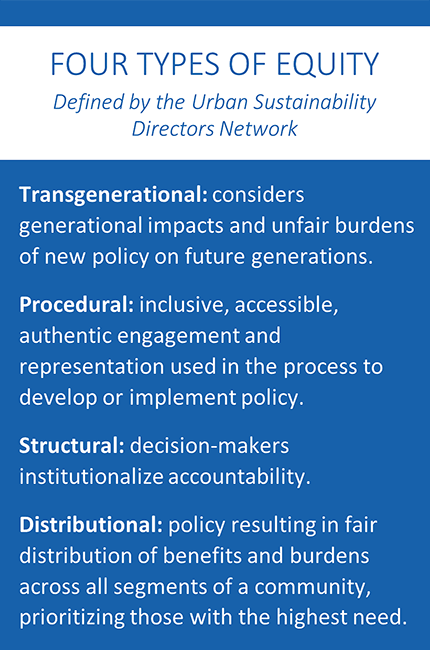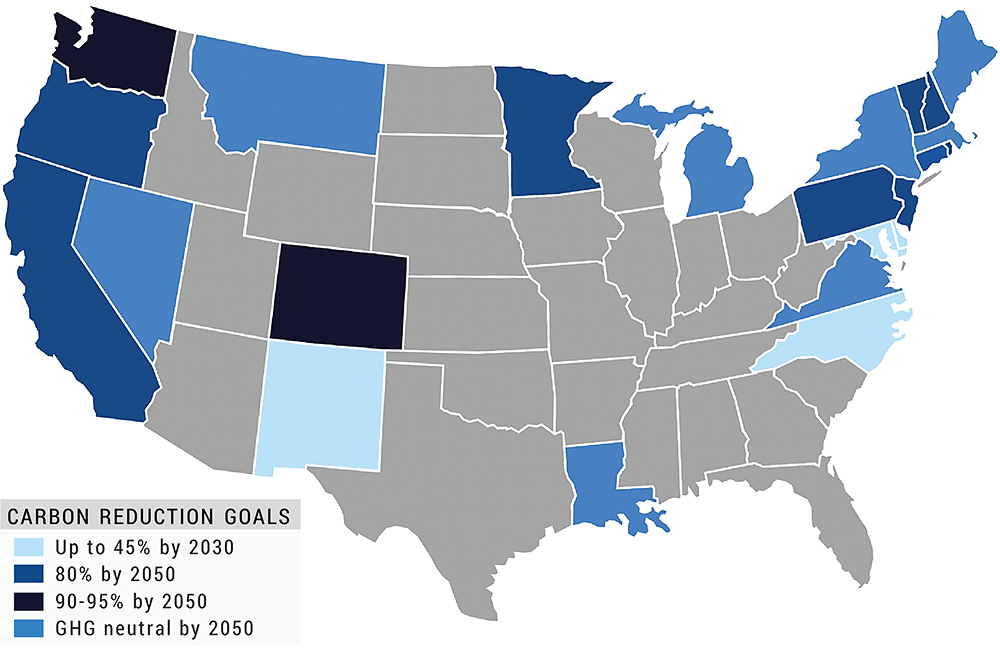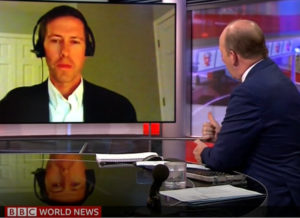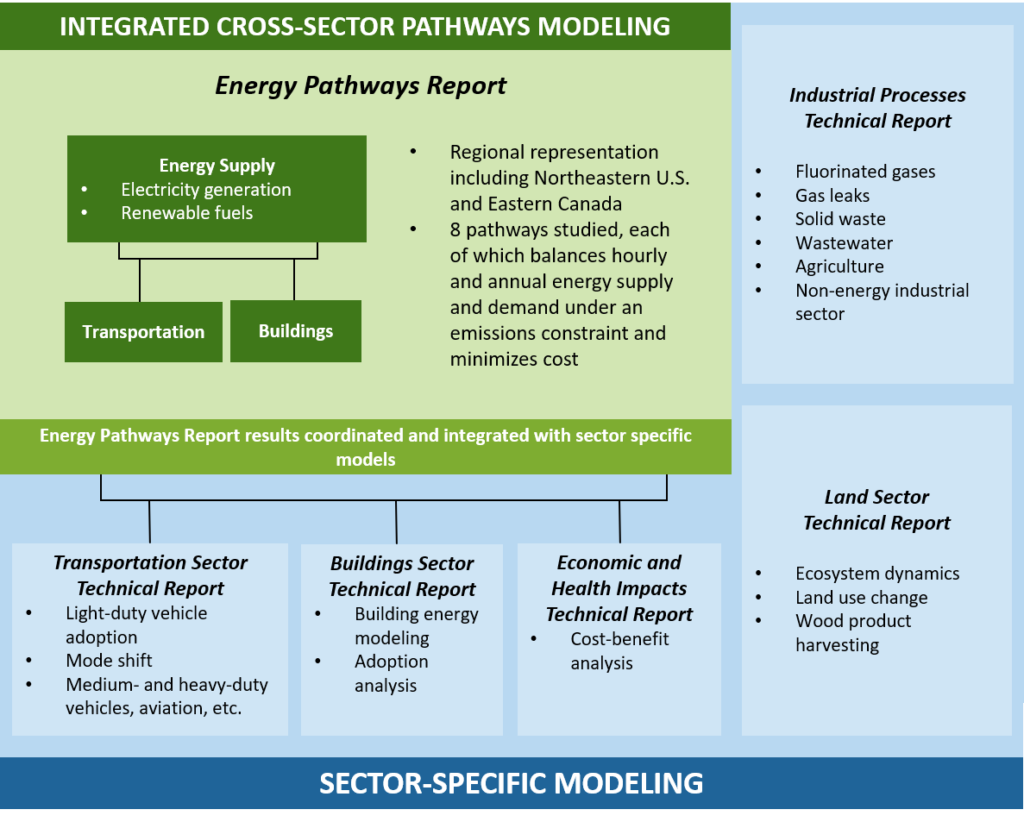Analyze market sectors, define paths to reduce emissions, and achieve climate goals.
Decarbonization
Evaluate your baseline, set goals, and advance your mission
Every day, more companies, communities, and organizations commit to reducing their contributions to global greenhouse gas emissions. Some are acting in response to calls for sustainable practices; others to realize financial, reputational, risk mitigation, or other co-benefits; still others have signed on to commitment platforms at the national and subnational level.
No matter what the motivation, Cadmus can help your organization establish and achieve its decarbonization goals. From conducting a greenhouse gas emissions inventory and setting science-based emissions targets to identifying and supporting the implementation of emissions reduction strategies to support your transition to the low-carbon economy.
We work closely with clients to benchmark their efforts relative to their peers, customers, and suppliers, align with best practices and emerging market standards, develop innovative financing strategies, and report to leading disclosure platforms.
While some consultants offer a one-size-fits-all practice, we believe the most successful results come from a tailored approach to meet the unique goals of each client. Our customizable tools and experience allow us to accurately predict and improve performance, so our clients can demonstrate significant improvements year over year—often far exceeding their own goals.
The Path to Climate Leadership Starts in Low-Income Neighborhoods
Insights from Grid Forward 2020

GridFWD 2020, hosted by Grid Forward, convened energy service professionals from across the Pacific Northwest in an online forum to explore the many changes, perspectives, and solutions regional stakeholders are pursuing to support reliable, affordable electric service and the well-being of customers, co-workers, and communities. In this series of articles, Cadmus presents insights from experts at the conference and the solutions industry leaders are exploring to advance equity in resilience.
January 19, 2021
By Jeana Swedenburg
Competitive market drivers, state and local policy, and the increased availability of cost-effective energy supply alternatives are forcing utilities to consider opportunities for customer-centric renewable energy programs. Innovations in energy supply can drive solutions that not only advance the functionality of utility grid systems but also address systemic equity and access issues for all communities. Utilities must plan programs that address the needs of their most vulnerable populations in order to comprehensively address climate challenges. During a session at GridFWD 2020 entitled, "How Increased Grid Innovation Creates a More Equitable Future," panelists discussed how they are engaging underrepresented communities in energy decision-making to pave a path forward.
Defining Equity
The Urban Sustainability Directors Network defined four types of equity for sustainability planning, decision-making, and program and policy design. These four aspects of equity are necessary considerations for utilities as they strive to make grid innovations that benefit all customers:

Transgenerational Equity: decisions consider generational impacts and do not result in unfair burdens on future generations.
Procedural Equity: inclusive, accessible, authentic engagement and representation used in the process to develop or implement programs or policies.
Structural Equity: decisions made with a recognition of the historical, cultural, and institutional dynamics and structures that have routinely given advantage to privileged groups in society and resulted in a chronic, cumulative disadvantage for subordinated groups.
Distributional Equity: programs and policies result in fair distributions of benefits and burdens across all segments of a community, prioritizing those with the highest need.
Transgenerational Equity: Future-Proofing Policy
Across the United States, state legislators are pushing for a clean energy future for the generations to come. Currently, 23 states and the District of Columbia have established economy-wide greenhouse gas emissions targets that strive for significant carbon reductions (or, in many cases, carbon neutrality) by 2050 to reduce the consequences of climate change. Climate change poses significant economic, public health, and environmental risks to society and considerable evidence indicates that such challenges disproportionately threaten minority and low-income communities-communities that remain underrepresented in clean energy planning decisions. Because of this, many states are mandating that utilities consider these inequities when driving grid modernization and that they develop solutions to offer a clean energy future for all. Washington state's 2019 Clean Energy Transformation Act outlines a plan for electric utilities to decarbonize energy production with provisions to ensure that clean energy benefits are equitably distributed. During GridFWD 2020, Debra Smith, CEO and general manager at Seattle City Light, said, "I love [the Clean Energy Transformation Act] because it's a great example of how policy can be good and encourage growth and change. … [It] is designed as a policy to move [Washington] toward a clean energy future but to do so in a way that doesn't leave anyone behind and allows all members of Washington state to reap the benefits of this clean energy transformation."

This map includes economy-wide targets that were established either through statutory action or legally binding executive action (such as a governor's executive order). Currently, 23 states and the District of Columbia have established economy-wide greenhouse gas emissions targets. Source: Center for Climate and Energy Solutions.
Procedural Equity: Collaborating with All Customer Segments
Not only is offering equitable access to clean energy widely considered "the right thing" to do, it is also a practical necessity for achieving emissions reduction goals. According to the National Renewable Energy Laboratory, almost half of the country's rooftop solar potential is on low-income homes. As such, low-income voices must be part of the discussion to ensure the successful adoption of renewable energy technologies. As utilities set out to develop focused strategies for providing equitable access to clean energy, it is important for them to listen to members of frontline communities who experience the "first and worst" consequences of climate change.
During GridFWD 2020, Adjunct Professor of Practice at the University of British Columbia's School of Public Policy and Global Affairs, Andrea Reimer, explained that utilities and governments can often present solutions to marginalized communities without first asking about the needs and values of those community members. Reimer specializes in community engagement and ensuring that residents have a voice in public policy. To actively engage marginalized communities, she says, "The first place to start is by showing up not because you want something, but just to show up." Reimer said environmental advocates can push their way into low-income neighborhoods, stating, "You should take the [hydroelectric] dam, or you should take the solar, or you should take the wind because we know what's best for you" without really listening first.
Reimer told a story about a group developing green building policy in Vancouver. These policy decision-makers were frustrated that builders from the affordable housing community were not engaging in scheduled meetings to discuss policy innovation. Upon hearing these frustrations, Reimer realized that the policy meetings were held at city hall, during the middle of the day, and were being hosted by English-speakers. All these factors made community engagement convenient for the decision-makers but challenging for local builders, who are predominantly first-generation Chinese and South Asian and whose jobs do not readily allow them to attend midday meetings. Reimer worked with these decision-makers to develop a plan so they could integrate into these builders' communities to first hear how they feel about green building practices. She encouraged policymakers to meet with builders at their places of worship-a safe space where they feel culturally connected. After implementing this strategy, policy decision-makers realized that the builders were very interested in green building practices, and they are now an integral part of creating green building regulations. These builders are pushing for more stringent regulations and proposing ideas to accomplish greener buildings. Reimer emphasized, "Meet people where they are at-don't draw people to your engagements. Go into their communities and listen to the engagements they are having and what issues they care about and listen, look, learn, and then figure out how to co-create some opportunities together."
Structural Equity: Learning Lessons from the Past
Historical policy decisions, such as redlining, have created an undue climate burden for residents of low-income and minority neighborhoods. Across more than 100 cities, a recent study found that formerly redlined neighborhoods are 5 degrees hotter in the summer today, on average, than areas once favored for housing loans, with some cities seeing differences as large as 12 degrees. Redlined neighborhoods, which remain lower income and more likely to have Black or Latino residents, consistently have far fewer trees and parks that help cool the air. They also have more paved surfaces, such as asphalt lots or nearby highways, that absorb and radiate heat.
These policy implications make climate a gentrifying concept that further drives neighborhood-based inequity. Some properties become more valuable than others due to their ability to better accommodate settlement and infrastructure in the face of climate change. For example, residents with financial means may move away from the aforementioned inner-city communities that experience extreme heat and seek refuge in suburbs with cooler temperatures. This causes an undue burden on lower-income households as suburban property values increase and inner-city housing prices become devalued. Conversely, rising sea levels and flood risks may push residents from previously desirable coastal communities inland. A 2018 study found that the value of higher elevation property in Miami-Dade County rose from 1971 to 2017 while that of lower elevation property declined. Utility grid resilience efforts and system innovations to prepare for a changing climate should consider more than just infrastructure updates, because adding resilient infrastructure may also cause additional gentrification as the more advantaged move into less risky areas and force underprivileged residents out.
During GridFWD 2020, Smith discussed how Seattle is evolving in this area: "We do see the opportunity to rebuild our city in a way that is… more racially just, more environmentally equitable. We are doing a lot of work right now across the city… [to] reimagine the space in ways that honor all the people that live here." The Urban Sustainability Directors Network published an example of how Seattle took action to address inequity that improves services for everyone: a story of streetlight repairs. Like many cities, Seattle's public works department historically repaired streetlights upon request. Residents would phone in complaints and city workers would show up and replace light bulbs. This process left poor neighborhoods in the dark: more streetlights in low-income neighborhoods were in disrepair than streetlights in other areas of the city. Because the life span of a streetlight bulb is predictable, the city changed its process and is now fixing streetlights on a regular schedule. This addresses the inequity across neighborhoods and benefits everyone, including wealthier residents who no longer have to call the city to make a complaint. By addressing the needs of the least well-served neighborhoods, everyone benefited.
Distributional Equity: Understanding Determinants of Disparity
Reimer encouraged attendees of GridFWD 2020 to remove the obstacles that keep marginalized communities from enjoying the benefits of clean energy rather than creating short-term solutions for access. In 2019, Tony Reames, director of the Urban Energy Justice Lab at the University of Michigan, defined energy justice as "fair and equitable access to energy technology [and] fair and equitable participation in energy decision-making." Reames indicated that energy is a basic right because it is so important to everything we do in life, which means energy needs to be affordable, clean, and efficient. Low-income households struggle with rising energy costs, yet, as Reames' research shows, they often have the least access to energy-efficient or clean energy technologies.
For equity to have meaning, it must be connected to an understanding of how group identity shapes people's lives. To achieve energy justice, utilities must not only consider customer segment economics but must also identify the specific demographics of those within a community who need to be fully engaged and whose opportunities and access need to be improved. Several customer groups are most impacted by policy decision-making and have life outcomes that are disproportionately affected by the existing structures in society: people of color, individuals with limited English proficiency, and age outliers (the young and the elderly). According to the U.S. Energy Information Administration, of those who are struggling to afford their energy bills in the United States, about half are Black and 40% are Latino. This is true despite the fact that ethnic minorities are engaged clean energy advocates. Prior research shows that people of color in the United States are more concerned than white Americans about climate change. Latinos, in particular, are much more engaged with the issue of global warming than non-Latinos. Latino Americans are more convinced that global warming is happening and is human-caused, are more worried about the situation, perceive greater risks, are more supportive of climate change policies, and are more willing to get involved politically than Americans of other ethnicities.

Listening to members of disenfranchised communities and designing clean energy programs and policy that are accessible to all is the clear path to energy justice and climate leadership. To improve climate change action across diverse audiences and more effectively support public engagement and adoption, it is imperative to conduct customer research that goes beyond understanding whether customers participate, but that also explores what renewable energy options customers want and how and why they take certain actions within the context of a renewable energy program. As Reimer said, "If we are [designing solutions] exactly the same way in a clean energy world as we were in a dirty energy world, we're probably not moving that far ahead." It's time to listen up.
More GridFWD Insights
Utility Resource PlanningEquitable Resilience in the GridA look into the state of power outage resilience for disadvantaged communities across three at-risk regions in the United StatesUtility Resource PlanningThe Role of Wholesale Markets in Grid DecarbonizationLessons from the Western Energy Imbalance Market
Guiding Airports to Develop a Zero-Emissions Roadmap
Low-Emissions Roadmap at Airports on behalf of the National Academies' Airport Cooperative Research Program. We spoke to Geoff about why Airport Zero Emissions Planning is such an important topic for airports right now and how a roadmap can help airports through that process.
What is driving airports to develop zero-emissions roadmaps?
Across all sectors of the economy we are experiencing the very real impacts of climate change and businesses, organizations, and government agencies are implementing strategies to aggressively reduce greenhouse gas (GHG) emissions. The aviation industry is one of the most challenging to decarbonize given its reliance on carbon-based fuels, significant increase in global travel (despite the pandemic, passenger travel is expected to rebound and continue to grow), and extensive ground operations and infrastructure needed to support that travel. Airports are looking for guidance on deploying new technologies, adopting innovative financing mechanisms, and implementing long term planning to meet local, state, and in some cases global carbon reduction goals.

What gap does the roadmap fill for airports? What are the unique challenges to developing a zero- emissions roadmap?
Airports are adept at addressing a range of environmental problems and have a long history of planning and implementing well-established solutions to address issues such as noise, storm water runoff, and wildlife management. However, reducing GHG emissions presents a coordination challenge because it must be incorporated into airports' long term airport zero emissions planning horizons.
When airports are planning to reduce emissions, they are typically planning to get to zero emissions, which often takes 20-30 years. They have to keep their short term needs and long-term goals in perspective at the same time. It also requires airports to consider all life-cycle phases of potential solutions from planning, design, and operations through end of life. This is a unique coordination challenge for airports that involves a lot of stakeholders and a lot of steps. A roadmap can provide a consistent framework to gain support for the process and apply the latest guidance to ongoing zero- emissions planning processes. It's an effective tool because we can help an airport ultimately create a single document that unites a diverse set of actors, while also allowing for flexibility to adapt to changing conditions and rapidly evolving technologies.
What are the components of a zero-emissions roadmap?
In Cadmus' approach to developing an airport zero emissions planning roadmap, we have identified six central steps:
- Initiation of the Roadmap - Understanding the local context for creating a roadmap, making the business case, and establishing a management structure.
- Stakeholder Engagement - Identifying stakeholder groups and managing communications throughout development of the roadmap.
- Setting Emissions Goals, Baselines, and Targets - Following a step-by-step process from conducting a GHG inventory to defining goals and targets.
- Emissions Reduction Strategies - Identifying and selecting methods to help the airport reduce Scope 1, Scope 2, and Scope 3 emissions.
- Funding Opportunities and Mechanisms - Evaluating the pros and cons of available public, airport-based, and third-party funding mechanisms.
- Monitoring and Outreach - Establishing internal processes to ensure the roadmap can be maintained over time.

When we work with airports, we facilitate discussion, support data collection, undertake extensive quantitative and qualitative analysis, and provide technical support as the stakeholder teams work through each of the steps. Cadmus has worked with numerous airports and regularly helps airports initiate, implement, and track sustainability programs. We bring first-hand experience with implementing solar and wind projects, electric vehicle programs, and energy efficiency initiatives, as well as technical, financial, and policy changes affecting the airport industry.
We prepare a consolidated roadmap document that signals the airport's commitment to addressing climate change, guides the airport in planning, and identifies actionable decision points. The roadmap also establishes clear metrics which help facilitate continuous improvement. There is not a one-size-fits-all solution; our goal is to help airports establish a structured approach to developing the processes, practices, and tools needed for long-term achievement of zero emissions.
How does a zero-emissions roadmap add value to an airport's existing planning and management cycle?
One of the most important things the roadmap does is create momentum and get stakeholders working toward a common goal. Successful emissions reduction strategies require extensive involvement from and coordination with diverse actors-from airline employees and other airport tenants to local and state government to ground transportation providers. Working through the roadmap process creates buy-in for the airport's long term zero-emissions goal and helps stakeholders understand their distinct role in achieving critical milestones toward that goal.
Airports have already made great strides in expanding their sustainability initiatives and working toward net zero in their facilities. This is also an exciting time in the aviation industry more broadly as trends around aircraft electrification, sustainable aviation fuel, and other technology developments continue to help drive reductions in GHG emissions. We're proud to help our clients understand the implications of these trends and explore opportunities to apply them to their airport operations.
Learn more about Cadmus' approach to airport zero emissions planning.
The full Guidebook for Developing a Zero- or Low-Emissions Roadmap at Airports is available for download through the National Academies website.
Guidebook for Developing a Zero- or Low-Emissions Roadmap at Airports
Learn the Step-by-Step Process

January 9, 2020 - Cadmus authored a significant new guidebook that provides a detailed step-by-step process for achieving zero- or low-emission airports. Interest in lowering airport emissions is at an all-time high, and airports worldwide are setting aggressive zero- or low-emissions targets. To meet these targets, airports are deploying new strategies, adopting innovative financing mechanisms, and harnessing the collective influence of voluntary emissions and reporting programs. In tandem, new and affordable zero- or low-emissions technologies are rapidly becoming available at airports. This guidebook, led by Cadmus' Sustainable Transportation Practice, is the first guidebook focused solely on supporting airport staff in achieving deep emission reductions.
Key features of the guidebook include:
- Basic concepts and knowledge to begin the road mapping process
- Effective engagement strategies to encourage buy-in from internal and external stakeholders
- Steps for setting goals, baselines, and targets
- How to prioritize emissions reduction strategies
- Funding opportunities and mechanisms
- Key steps for monitoring, outreach, and reporting
Cadmus led a team that included Rocky Mountain Institute, HMMH, Changing Climate Consultants, and the Volpe Transportation Center. This project was conducted on behalf of the Airport Cooperative Research Program (ACRP), a program managed by the Transportation Research Board (TRB) of the National Academies and sponsored by the Federal Aviation Administration.
The Guidebook is available for download through the National Academies website.
Decarbonization Roadmap for Massachusetts
Setting a Path for Decarbonization with the Commonwealth of Massachusetts
The Massachusetts Executive Office of Energy and Environmental Affairs (EEA) seeks to protect, preserve, and enhance the Commonwealth's environmental resources while ensuring a clean energy future for the state's residents.
Challenge
The Commonwealth of Massachusetts is committed to achieving net zero greenhouse gas emissions by 2050. Massachusetts' Executive Office of Energy and Environmental Affairs (EEA) leads implementation of this effort, as the office responsible for advancing the Commonwealth's Global Warming Solutions Act (GWSA). Ahead of developing a 2030 Clean Energy and Climate Plan, as required under the GWSA, EEA sought to determine the ways in which Massachusetts can achieve net zero emissions while maintaining a healthy, equitable, and thriving economy. EEA developed a scope of work to determine the long-term pathways available for achieving this ambitious goal to ensure near-term decision-making was based on best available information.
Solution
To conduct this Decarbonization Roadmap Study, EEA engaged a team of technical experts led by Cadmus. To address EEA's specific research needs, the Cadmus team utilized both an integrated, cross-sector energy system analysis and sector-specific analyses to identify the transformations necessary for Massachusetts to achieve its 2050 climate goals. The Cadmus team evaluated eight distinct economy-wide decarbonization pathways, as well as the transformations that are likely to drive emissions reductions in the transportation, building, energy, and non-energy sectors. The team also evaluated the economic and public health impacts associated with these changes, and the carbon sequestration capacity of natural and working lands in Massachusetts to achieve net zero emissions in 2050. Finally, Cadmus advised on the near-term climate actions necessary to achieve an interim emissions reduction by 2030 that is in line with net zero by mid-century.
Figure 1: Overview of analytical approach
During each phase of the project, Cadmus worked with EEA to:
- Utilize data analysis and decarbonization models to inform the Commonwealth's research questions.
- Assess policy priorities, identify technologically feasible solutions, and analyze potential impacts of implementation.
- Integrate and articulate findings in a manner that made technically complex information accessible to a wide range of audiences.
One of the unique challenges of this project was finding a manageable way to explore the complexity of economy-wide decarbonization given that fossil fuels power virtually every aspect of our economy and daily lives. The Cadmus team applied a systems engineering approach, which is based on the idea that in complex systems the parts cannot be easily separated from the whole without losing critical interactive effects that can fundamentally impact the overall findings. Instead of looking at decarbonization solutions one sector at a time, the Team integrated their findings from all sectors to look at the "big picture." This approach allowed the Cadmus team to consider whether GHG reduction success in one sector could be at the expense of reductions somewhere else, or could be unsustainable systemwide, and also helped inform how to appropriately allocate resources in the near term to achieve economy-wide decarbonization in the long term.
Results
The Cadmus team's extensive cross-sector analysis identified potential reductions pathways to achieve the Commonwealth's net zero goal, as well as the associated costs and benefits of each. The results are presented EEA's final Massachusetts 2050 Decarbonization Roadmap, published in December 2020 along with the associated technical reports.
Figure 2: Four key "pillars of decarbonization" for the Commonwealth

Key findings indicate that the following must occur by 2050 to achieve net zero emissions:
- Wind and solar power are widely deployed to decarbonize the grid and meet the growing demand for clean electricity. A diverse set of energy resources and improved transmission and distribution systems all play a role in operating the decarbonized grid.
- Passenger vehicles are largely electrified, with other transportation modes requiring greater energy densities using cleaner fuels like hydrogen or biofuels.
- Heating and cooling systems are electrified using heat pumps, while electric appliances and energy efficient buildings reduce overall energy use.
- Acting quickly is pivotal to decarbonizing transportation and buildings sectors due to infrastructure needs and stock turnover constraints (the amount of times a consumer replaces a vehicle or gas furnace between now and 2050).
- Strategic management of forests and other natural and working lands in the Commonwealth is important to enhance carbon sequestration.
- Decarbonizing the Commonwealth's energy systems will require substantial investments over the coming decades but is an investment that creates significant economic opportunity and that will pay dividends across the Commonwealth for generations to come.
Based on the key findings from the Roadmap, Cadmus supported EEA in developing the Interim Massachusetts 2030 Clean Energy and Climate Plan (CECP) which lays out priorities for achieving reductions in the building, transportation, energy and non-energy sectors this decade, along with enhancing carbon sequestration on natural and working lands. EEA is currently refining the CECP to incorporate updates from An Act Creating a Next Generation Roadmap for Massachusetts, signed by Governor Baker in March 2021, and will release a final version later this year that achieves a 50% emissions reduction this decade.
Chad Laurent Discusses Clean Technology Pledges with BBC News
Cadmus Principal Chad Laurent joined BBC World News to discuss the clean technology pledges made by world leaders at COP26 on Tuesday, November 2, 2021. Read and watch the interview between Cadmus Principal Chad Laurent and BBC anchor David Eades below for more discussion on the proposed actions and pledges that can make a real meaningful difference:
Click here to access a transcript of this video.
These pledges could lead to real actions both in sectors where we have the technologies and need to accelerate their deployment, such as renewables, electric vehicles, and grid modernization, and in harder-to-reach sectors like steel and agriculture. Next steps would be to see follow-through on these clean technology pledges, get some projects up and running, show success, and share results and lessons-learned with the global community.

The key challenge with making these pledges? Getting the rules, regulations, and policies right at every level of government in order to get clean technology financed and built out at scale. Each level of government has its own obstacles to overcome to create financial and building plans for projects that will support these clean technology pledges. Changes to regulatory frameworks will enable these policies to be developed and implemented. Commitments from governments and corporations are needed to create a market that helps move policy and regulations forward to accelerate this technology.
About Cadmus
Cadmus is a strategic and technical consultancy compelled to help solve the world’s most challenging problems. We assemble outstanding teams of leading experts leveraging transformative technologies to work seamlessly across disciplines to help you achieve extraordinary results. From energy, water, and transportation to safety, security, and resilience—together, we are strengthening society and the natural world. Cadmus’ more than 700 consultants serve government, commercial, and nongovernmental organizations around the world. For more information, visit www.cadmusgroup.com.
